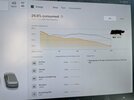Having some issues with energy use while going downhill. I have had my Model 3 (2018 LR AWD, 18" w/ aero covers) for just over 2 years. At first, I would be able to match or beat the trip planner. I put a set of DWS06 tires on it and started to notice an increase in energy use when doing the long downhill into CA, but I chalked it up to not having the eco-focused tires. I recently put on a set of the OEM MXM4 tires and had an alignment done at the SC where they got it dialed in to factory specs. I am still using way more energy downhill than the trip planner is estimating.
On a recent drive from Truckee, CA to Sacramento, CA (starting at about 5,800ft to donner pass at 7,100 to Sacramento at 100ft or so) I used about 50% more energy than the trip planner estimated (elevation shows nearly 10% more SOC used than expected). I started the drive in Reno, NV and supercharged in Truckee, so I had a warm battery. No regen limit dots, tire pressures 42-44, speed mostly around 70, 75 once closer to Sacramento, and almost all on autopilot. I have done this drive many times and ever since that first tire change I have been having this issue regardless of season, weather conditions, or speed. I have included a picture of the trip planner at the end of my drive and you can see that it really starts to deviate during the downhill portion when the car was expecting the SOC to increase or stay about the same (starting at mile 10 or so and becomes very pronounced around mile 30).
It is strange because I can get fairly close to the estimate during level or uphill driving, it is just going downhill where I begin to deviate from the planner. I also want to note that I have the wheel settings in the car computer set to 18" without aero covers which should be planning on more energy use in general.
Any ideas on what might be causing this? It is making long road trips harder with the increased energy usage and the uncertainty of how much to charge up at the superchargers.
On a recent drive from Truckee, CA to Sacramento, CA (starting at about 5,800ft to donner pass at 7,100 to Sacramento at 100ft or so) I used about 50% more energy than the trip planner estimated (elevation shows nearly 10% more SOC used than expected). I started the drive in Reno, NV and supercharged in Truckee, so I had a warm battery. No regen limit dots, tire pressures 42-44, speed mostly around 70, 75 once closer to Sacramento, and almost all on autopilot. I have done this drive many times and ever since that first tire change I have been having this issue regardless of season, weather conditions, or speed. I have included a picture of the trip planner at the end of my drive and you can see that it really starts to deviate during the downhill portion when the car was expecting the SOC to increase or stay about the same (starting at mile 10 or so and becomes very pronounced around mile 30).
It is strange because I can get fairly close to the estimate during level or uphill driving, it is just going downhill where I begin to deviate from the planner. I also want to note that I have the wheel settings in the car computer set to 18" without aero covers which should be planning on more energy use in general.
Any ideas on what might be causing this? It is making long road trips harder with the increased energy usage and the uncertainty of how much to charge up at the superchargers.



